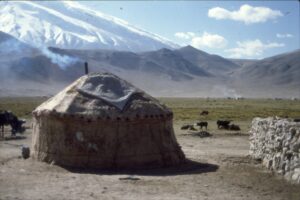
I’ve been discussing the design of Late Neolithic houses in Orkney. Is it an economic and efficient use of space or is it constrained by something else? Is it a product of a highly ritualised society, or just ‘something that works’?
I’m struck by the way in which the interior fittings of the houses resemble the layout of similar structures such as yurts and tipis. Faegri’s book ‘Architecture of the Nomads’, which has long been a favourite of mine, illustrates examples of both circular and rectangular houses where the sacred area lies across the hearth from the entrance and where the spaces to either side of the fire are separated (usually by gender, sometimes by age, and occasionally between family and visitors). Of course, there is only a limited number of ways in which a family can live in a restricted single-room space such as this. But it is interesting that over the millennia, so many communities seem to have done so very successfully. The concepts of privacy and adequate space with which we tend to judge archaeological dwellings are very western and very modern.
Everything at Skara Brae revolved around the central hearth; this is an obvious place to have your heating and cooking area, though some have expressed surprise that it takes up so much space. It is important to remember that the actual fire does not need to fill the hearth stone. The hearth stone itself can have greater significance than simply retaining fire; more prosaically, it can provide a necessary boundary between people and fire, as well as offering space on which to set pots and anything else that may need to dry or be kept warm. Immediately opposite the door, across the fire and probably only visible through smoke as you enter, lies the ‘dresser’. This was once interpreted as straightforward domestic shelving, but is now seen as something a little more complex, somewhere between an altar and show cupboard, depending on your views. To either side of the hearth are large stone compartments, interpreted as beds. In the earlier houses these are set back into the wall and bear a strong resemblance to the stone beds set into the walls of 17th century Orkney farmhouses. The assumption is that, as with the historic box bed in Orkney, they were slept in by several members of a family group at any one time. There are other features: stone-lined pits, a compartment for rubbish, a wall-cell, together these form the principal elements that made up a home for the Neolithic inhabitants of Orkney.
We assume that each individual house was inhabited by an extended family. In order for any group to survive in this restricted space, it is clear that rules must have existed and been carefully adhered to. This is common practice, measures like this develop in any society to stop us getting on top of one another as well as to maintain the social norms afforded to gender and age. They might seem a little harsh, but in reality we all adhere strictly to social convention with regard to our own homes: when visiting a friend, it is not ‘done’ to wander into their bedroom and shuffle through the drawers; we are careful in the sitting room; and offer to help in the kitchen. Think of the number of teenagers whose rooms become a haven set apart from the rigours of the adult world. I guess that a successful social norm is one that you hardly notice.
Yurts provide a good example of the deeper meaning that can reside within a house structure. Both Faegri, and Oliver in his book ‘Dwellings’, discuss the way in which the layout of the interior has come to represent the cosmos for those who inhabit them. Interestingly, both consider how the structure, though circular, incorporates hidden rectangles representing the four corners of the Earth (pages 92 – 93). These can be indicated by the placing of posts or significant furnishings as well as by the use of a substantial hearth stone. It is of course possible to determine a similar transformation at Skara Brae not only with the hearth and other fittings but between the straight-sided interior and the curved walls of the exterior. I’ve noted a similar feature: ‘the square inside the circle’, at other monuments here in Orkney, such as Barnhouse, as well as at sites like Stonehenge. Oliver notes the way in which this is a powerful motif in Buddhist symbolism, representing the male and the female in life. Today it is used by UNESCO to signify the duality between nature (the circle) and culture (the square).
Some find the houses at Skara Brae horribly uniform and impersonal. Yet many of our own housing estates demonstrate uniformity, especially those of the immediate post-war years, but it doesn’t mean that we live in an egalitarian utopia. This would be to forget people’s ability to decorate and alter. We see the mere stone bones of the houses. The Neolithic dweller had numerous ways to personalize their space. Archaeology is always simple and monochrome, but the creative had texture, colour, and shape to make use of. Hides, felt, wool itself, plant materials: the possibilities are (and were) endless.
The houses of Late Neolithic Orkney did not arise out of nothing, though some argue that they went on to influence Neolithic house-building across the UK. With the introduction of farming there were so many changes, including, perhaps, an initial and short-lived need for accommodation that suited slightly larger groups as evidenced by the aisled (or stalled) halls at sites like Crathes, that it is not surprising to see some change through the period. Colin Richards has recently devoted much effort to discussing the transformations that triggered the appearance of the familiar Skara Brae-type house. His argument encompasses a wider field than simple construction needs to consider social and cultural developments at the time and it is a compelling theory. Of course he is right to look beyond mere physical shape, but it is also interesting to note the general trend for ‘round houses’ that both precedes and follows the Neolithic. The structures at Skara Brae do seem complex in their detail in comparison to surviving Mesolithic and Bronze Age evidence, but it is hard to judge to what extent this is a factor of the medium in which they were built. The available slabs of Orcadian stone allow for the survival of detail which the average Mesolithic and Bronze Age house-builder can only envy.
So, what is my over-riding conclusion? Are these houses special and different? Where did they come from? I’d prefer to avoid applying our value-laden urban ideas of what might have been needed and how to achieve it. Our needs differ so greatly from those of the average farmer 5000 years ago. If anything, I’d see the Early Neolithic houses as indicative of the introduction of new ideas rather than the later ones. To my eye, the type of dwelling that we see at Skara Brae represents a clever blend of Early Neolithic design with previous norms of circularity.
Whatever its origin, I am convinced that it was simply ‘what you lived in’, if you happened to be among the farming community in Orkney 5000 years ago.
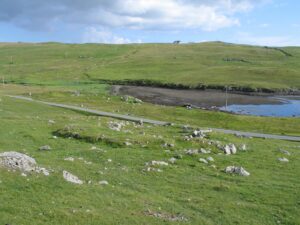

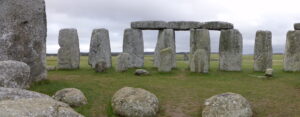
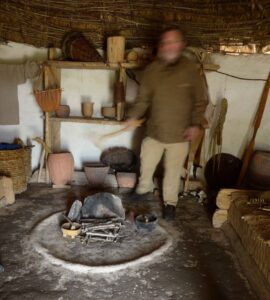
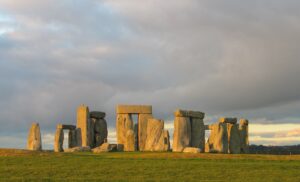
You must be logged in to post a comment.